Dog muzzle training is an essential skill for responsible dog owners, ensuring safety in situations where a muzzle is necessary. Whether for veterinary visits, grooming, or public spaces, a well-trained dog will feel comfortable wearing a muzzle. This guide explores the benefits of muzzle training and offers practical steps to help your dog accept it positively.
Why Muzzle Training is Important
Muzzles are often misunderstood, but they serve a valuable purpose. They help prevent unwanted biting, protect dogs during medical treatment, and reduce stress in unfamiliar environments. Training your dog to wear a muzzle ensures they associate it with positive experiences rather than fear or restriction.
Choosing the Right Muzzle
Selecting the right muzzle is crucial for effective training. Basket muzzles are a popular choice as they allow dogs to pant, drink water, and take treats. Avoid fabric muzzles for extended use, as they can restrict breathing and cause discomfort. Ensure the muzzle fits securely but comfortably, allowing your dog to open their mouth slightly.
Step-by-Step Muzzle Training
Introduce the Muzzle Gradually
Start by allowing your dog to sniff and investigate the muzzle. Hold it in your hand and reward them with treats whenever they show interest. This step helps create a positive association.
Encourage Voluntary Interaction
Place treats inside the muzzle and encourage your dog to put their nose in to retrieve them. Let them pull their head back out freely. Repeat this process several times until they willingly place their nose inside.
Secure the Muzzle Briefly
Once your dog is comfortable putting their nose in the muzzle, gently fasten it for a few seconds before removing it and rewarding them. Gradually increase the time they wear it, always offering praise and treats.
Build Duration and Movement
Encourage your dog to move around while wearing the muzzle, engaging them in short play sessions or walks. Keep training sessions short and positive, ensuring they remain comfortable.
Common Challenges and Solutions
Pawing at the Muzzle: If your dog tries to remove it, distract them with treats or toys.
Refusing to Wear It: Go back a step and reinforce positive associations with rewards.
Fear or Anxiety: Avoid forcing the muzzle on; instead, work at your dog’s pace with patience.
Final Thoughts
- Dog muzzle training is a valuable skill that promotes safety and confidence. By using positive reinforcement and gradual desensitisation, you can help your dog feel comfortable wearing a muzzle when needed. A well-trained dog will associate the muzzle with positive experiences, making necessary situations stress-free for both you and your pet.
- If you’re considering muzzle training for your dog, start today with patience and consistency, ensuring a safe and happy experience for your furry friend.

